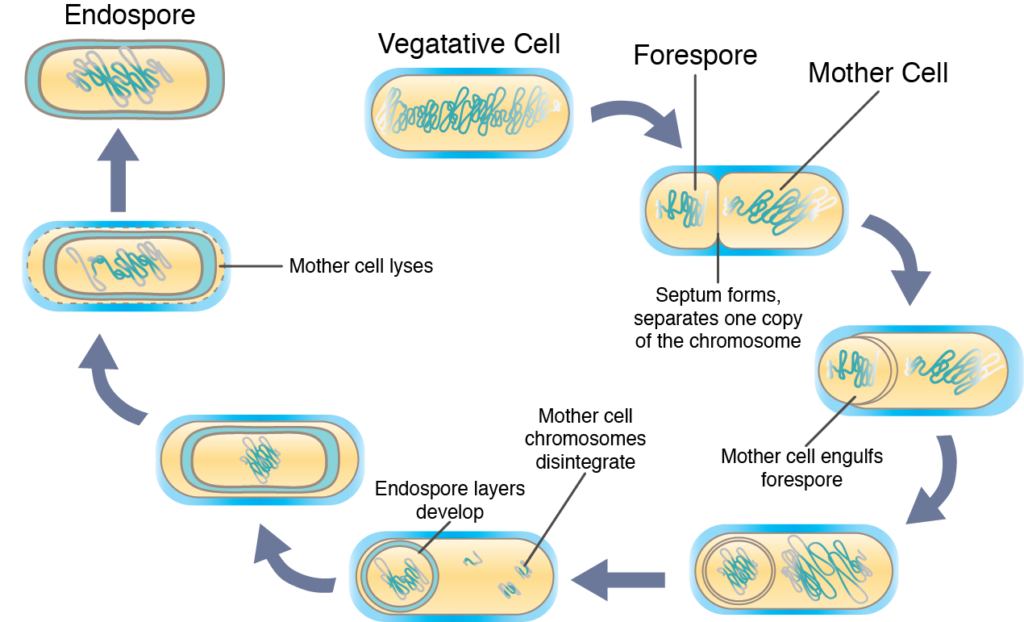1. Introduction
Bacteria are among the simplest yet most fascinating forms of life on Earth. Some bacteria can survive in extreme conditions like boiling heat, freezing cold, radiation, and even toxic chemicals. How do they manage this? The answer lies in their ability to form endospores.
To understand this ability, we need to know about two different bacterial forms:
- Vegetative Cell – the active, growing form.
- Endospore – the dormant, protective form.
In this explanation, we will explore what these two forms are, how they differ, and why this difference is so important for survival, disease, and microbiology.
Table of Contents
2. What is a Vegetative Cell?
A vegetative cell is a normal, living bacterial cell. It is the form that grows, divides, feeds, and performs all life functions.

Features of a Vegetative Cell:
- Actively metabolizes nutrients.
- Reproduces by binary fission.
- Sensitive to heat, dryness, chemicals, and UV light.
- Has a regular cell wall and membrane.
- Can be easily killed by antibiotics or disinfectants.
Simple Definition:
A vegetative cell is an active, living bacterial cell that performs normal life functions like growth, reproduction, and metabolism.
3. What is an Endospore?
An endospore is a special structure formed inside a bacterial cell during harsh or stressful conditions. It is dormant (inactive) and is built to survive.

Features of an Endospore:
- Very resistant to heat, radiation, dryness, chemicals, and disinfectants.
- Has multiple protective layers.
- Does not grow or divide.
- Can remain inactive for years or even centuries.
- When conditions become favorable, it can turn back into a vegetative cell.
Simple Definition:
An endospore is a highly resistant, inactive form of a bacterial cell that forms under stress and helps the bacteria survive extreme conditions.
4. Life Cycle: From Vegetative Cell to Endospore and Back
Some bacteria, like Bacillus and Clostridium, can switch between these two forms depending on environmental conditions.

Sporulation (Vegetative Cell → Endospore)
When the environment becomes unfavorable (lack of nutrients, high temperature, dryness), the vegetative cell forms an endospore inside it through a process called sporulation.
Germination (Endospore → Vegetative Cell)
When the environment becomes favorable again (presence of water, nutrients, suitable temperature), the endospore transforms back into a vegetative cell through germination.
This ability gives some bacteria a powerful survival advantage.
5. Detailed Differences Between Vegetative Cell and Endospore
Below is a comprehensive comparison of the two:
| Feature | Vegetative Cell | Endospore |
|---|---|---|
| State | Active, living | Dormant, inactive |
| Function | Growth, reproduction, metabolism | Survival under harsh conditions |
| Structure | Simple cell wall and membrane | Thick, multi-layered wall with protective coat |
| Metabolism | High – uses nutrients and oxygen | None or very minimal |
| Reproduction | Reproduces by binary fission | Does not reproduce |
| Resistance | Sensitive to heat, drying, radiation | Extremely resistant to heat, drying, radiation, chemicals |
| Formation | Normal condition | Only under stress (nutrient shortage, heat, dryness) |
| Killing Methods | Killed by antibiotics and heat | Requires autoclaving or strong sterilization |
| Microscope Appearance | Regular rod or spherical shape | Appears round, oval, or refractile (shiny) under microscope |
| Examples | E. coli, Staphylococcus | Bacillus, Clostridium species |
6. Importance of Endospores in Nature and Medicine
In Nature:
- Endospores help bacteria survive for thousands of years in soil, dust, water, and air.
- When conditions improve, they become active again and restart life.
- This cycle keeps bacteria alive even in volcanic areas, deserts, or frozen lands.
In Medicine:
- Some endospore-forming bacteria cause serious diseases, such as:
- Clostridium tetani – causes Tetanus
- Clostridium botulinum – causes Botulism
- Bacillus anthracis – causes Anthrax
- Endospores are hard to kill and can survive boiling, so medical tools must be autoclaved (sterilized at 121°C) to destroy them.
7. Why Is This Difference Important for Scientists and Doctors?
Understanding the difference between vegetative cells and endospores is crucial for:
- Sterilization – Endospores are harder to kill, so hospitals and labs use special sterilization techniques (like autoclaving) to destroy them.
- Disease Control – Diseases caused by endospore-forming bacteria can be life-threatening. Knowing their lifecycle helps in treatment.
- Food Safety – Canned and preserved foods are at risk if endospores are not destroyed.
- Microbiology Research – Studying these forms helps us understand how life survives in extreme environments.
8. Summary
Here’s a quick recap in table form:
| Aspect | Vegetative Cell | Endospore |
|---|---|---|
| Metabolism | Active | Inactive |
| Growth | Yes | No |
| Reproduction | Binary fission | None |
| Resistance | Low | Very High |
| Life Span | Short (days to weeks) | Long (years to centuries) |
| Formation | Under normal conditions | Under stress |
| Killed By | Antibiotics, heat, UV | Autoclaving, extreme heat |
| Example Bacteria | E. coli, Staph | Bacillus, Clostridium |
9. Conclusion
Vegetative cells and endospores are two faces of the same bacterium. One form (vegetative) is for living and growing, while the other (endospore) is for surviving the worst possible conditions.
This transformation is a brilliant example of nature’s way of protecting life. By switching between activity and dormancy, bacteria have managed to survive for billions of years, outliving many species.
Whether in medicine, food safety, or microbiology, knowing the difference between these two forms is key to controlling harmful bacteria, preserving health, and understanding microbial life.
FREQUENTLY ASKED QUESTIONS
Why do bacteria form endospores?
Bacteria form endospores to survive harsh environmental conditions like heat, dryness, lack of nutrients, or toxic chemicals. Endospores are strong, protective structures that keep the bacterial DNA safe until conditions improve.
Can endospores cause diseases in humans?
Yes, some endospore-forming bacteria can cause serious diseases such as tetanus, botulism, and anthrax. These bacteria stay hidden in the endospore form and become active when they enter a suitable environment like the human body.
How are endospores destroyed?
Endospores are highly resistant and cannot be destroyed by normal heat or disinfectants. They require autoclaving (high pressure and temperature—121°C for 15–20 minutes) to be completely killed and sterilized.
Related Articles




